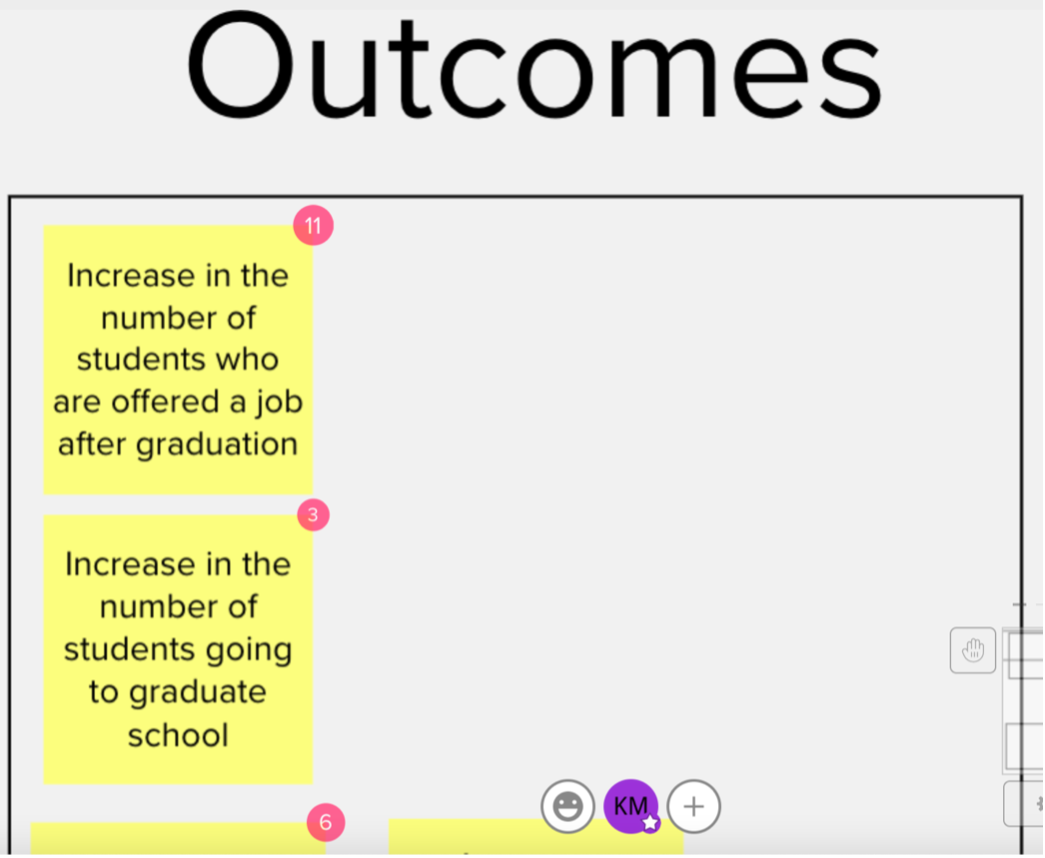
Hello, AEA! I am Kelly McGinn, Assistant Professor in the College of Education and Human Development at Temple University, where I teach our undergraduate program evaluation course. Due to the shift to virtual learning this year, I had to rethink how I engage with my students. I am typically a very hands-on practice-oriented instructor, and I had never taught an online course before. At first, I struggled to find ways to translate my typical teaching practice online. That is until I discovered Mural.
What is Mural?
Mural is a digital workspace for visual collaboration. This tool allowed my students and I to communicate visually using sticky notes, flowcharts, and drawing. There are also cool features like voting and timers.

How I used Mural
- I created an account for myself. Then when it was time to share my mural with the class, I could send them a guest link. They did not have to have individual Mural accounts themselves.
- When lesson planning, I could create a Mural template that my students and I would use in class later that week. For instance, ahead of time, I created a template for us to use when developing a logic model together.

- I often used the outline feature to guide students to different areas of the mural. For instance, students in Breakout Room 1 could click on “Breakout Room 1” in the outline and it takes them to their logic model box, where they could work with their group members to develop their logic model.
- I often included a “Directions” tab in the outline, where I would explain the task and demo the necessary features.


- There are several other cool features; one of which is a voting tool. After students had a chance to brainstorm in their groups, we were able to vote on the logic model components we felt were appropriate. Here you can see the number of students who voted for each of the outcomes they felt fit in this model.
Hot Tips:
Here are a few ideas for when to use Mural when teaching evaluation:
- Icebreakers or “Getting to know you” activities: Mural has many already-created templates that promote team building. I used a relay race type game in my class. Each group had a perform a number of tasks together. This game helped them get to know Mural, as well as each other.
- Creating a logic model: Across several class sessions we build a program’s logic model together.
- Developing evaluation questions: We used Mural to brainstorm evaluation questions for our group project.
- Creating an evaluation matrix: Mural helped us work together to write indicators and decide which evaluation tools we would use.
- Writing survey items: We used Mural to collaborate when developing our survey that we planned to distribute for our class project.
The ways to collaborate virtually using Mural are endless. The Teaching of Evaluation TIG would love to hear your ideas! Tweet your reflections using the hashtag #TeachingofEval21, and we can continue the conversation on the twitterverse!
The American Evaluation Association is celebrating TOE TIG Week with our colleagues in the Teaching of Evaluation Topical Interest Group. The contributions all this week to aea365 come from our TOE TIG members. Do you have questions, concerns, kudos, or content to extend this aea365 contribution? Please add them in the comments section for this post on the aea365 webpage so that we may enrich our community of practice. Would you like to submit an aea365 Tip? Please send a note of interest to aea365@eval.org. aea365 is sponsored by the American Evaluation Association and provides a Tip-a-Day by and for evaluators. The views and opinions expressed on the AEA365 blog are solely those of the original authors and other contributors. These views and opinions do not necessarily represent those of the American Evaluation Association, and/or any/all contributors to this site.

Hi Kelly,
I loved reading your post and learning about Mural! I am also taking the Queens course on program inquiry and evaluation. Like you, I am also a very hands-on type of instructor (I teach Elementary and Middle years) and found myself struggling to engage students during online teaching. Your post reminded me of when I taught last year at the height of the pandemic, I was desperately searching for all sorts of platforms to keep students engaged and keep participation high. Of course Microsoft and Google came up with a lot of really great sources we were able to use (jamboard, OneNote, etc.) but not quite like what Mural is sounding like.
Having almost finished the program inquiry and evaluation course, I feel like I have certainly learned a lot that I can incorporate into my classroom as well. I loved how you clearly collaborated with your students in order to create your logic models, and gave them the ability to work together on these concepts. It made me wonder how much we as students could have learned from each other through working together on our major long-term project or even some components of it. Shulha & Cousins (1997) enforced the use of collaboration as it benefits multiple parties and brings about a greater range of perspectives in order to create a stronger and more holistic outcome.
I also thought about Mural as a program for evaluation. How do these types of programs ensure engagement from the users? What are the goals of the program? What demographic is the program geared towards? Many of us were very lucky to have access to computers during the pandemic, however it wasn’t at everyones disposal. Program evaluations also need to engage and collaborate with the users of the program in order to establish its feasibility. I wonder what your thoughts would be on looking at Mural in the form of an evaluation.
Some more questions I wondered:
As an educator, what is Mural missing/what features do you consistently find yourself wishing it had?
What limitations does the workspace have?
After using Mural this past year, how did you find student engagement?
Thank you!
Hi Kelly,
My name is Amy Rowley and I am currently taking a course called “Program Inquiry and Evaluation” as part of a master’s program through Queen’s University. I thoroughly enjoyed reading your post about how you found an innovative way to shift your teaching practice online. While I have never heard of Mural before, I can see how it can be a valuable collaborative tool. As you explained in your “Hot Tips,” you were able to use Mural to engage your students in team building exercises, develop evaluation questions, create logic models and evaluation matrices, and write survey items.
Throughout my course, I have gained an understanding of how to evaluate social programs and have been tasked with developing a program evaluation plan. While I have engaged in this process individually, I wonder if a more collaborative model would have provided further benefits in developing my program evaluation plan. According to Superu (2017), the best logic models are produced using multiple voices, perspectives, and ideas, through a collaborative process. Although this involves a variety of resources, an agreed-upon model is far more valuable and useful than one that is created by one person (Superu, 2017).
I believe that collaboration affords many benefits in program evaluation, and I appreciate how you have included virtual collaboration throughout your course. I am curious whether or not you believe there may be some downsides to collaborative program evaluation design. Have you experienced any shortcomings in using this approach with your students?
Thank you for sharing your insights!
Amy
References
Social Policy Evaluation and Research Unit, Superu. (2017). Making Sense of Evaluation – A handbook for everyone. Superu. https://dpmc.govt.nz/sites/default/files/2018-03/Evaluation%20Handbook%20Dec%202017.pdf
Hi Kelly, I am a student at Queen’s University in Kingston, Ontario, Canada, currently taking a Master level course in Program Evaluation. I was recently introduced to the this blog as part of the course, and I have enjoyed reading many of the entries as I learn more about the field of evaluation. I was interested in your post regarding Mural, as I too discovered it this year and I have really enjoyed using it. In particular, I have appreciated the option for anonymous voting on Mural. Synthesis of ideas is an important part of problem solving, and anonymous voting removes all bias and gives everyone a voice. I have found in the past that more junior team members will hesitate in speaking up, or will vote for the most senior members POV despite having a difference of opinion. Even when teams get back together in real life, I hope some of the benefits of virtual collaboration will be here to stay.